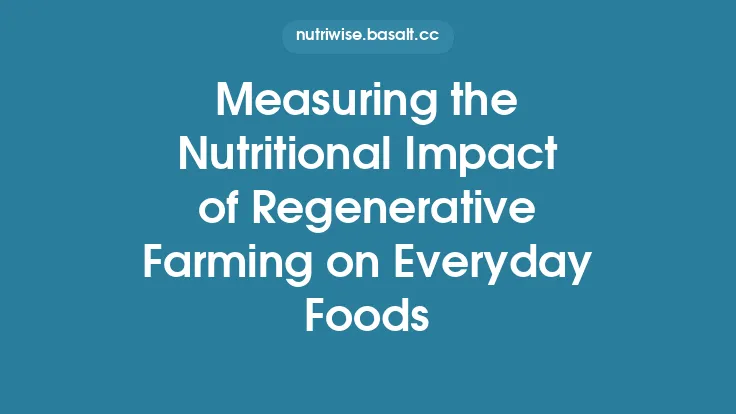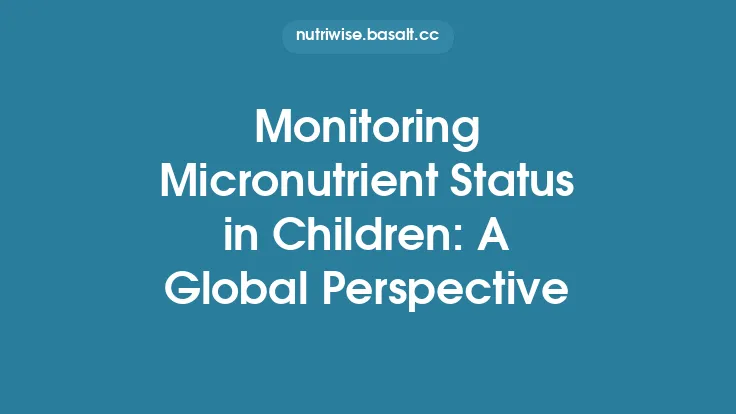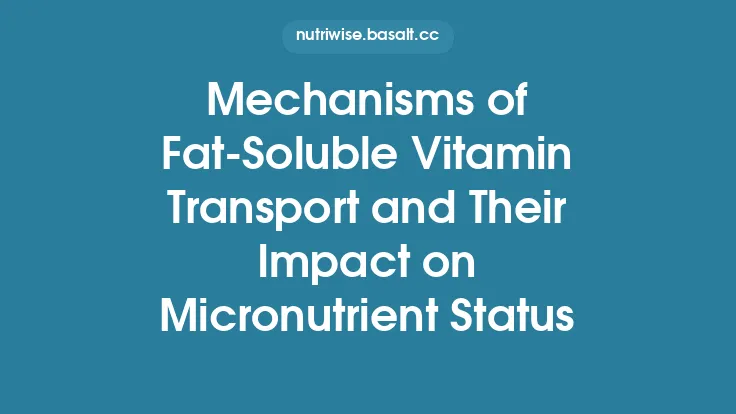Urbanization, defined as the increasing proportion of a population living in cities and the expansion of urban areas, is one of the most powerful demographic forces shaping health outcomes worldwide. Over the past half‑century, the global urban share has risen from roughly 30 % in 1950 to more than 55 % today, with projections indicating that nearly 70 % of humanity will reside in urban settings by 2050. This massive shift reconfigures food systems, alters physical activity patterns, modifies socioeconomic structures, and reshapes access to health services—all of which converge on the nutritional status of individuals and populations. Understanding the epidemiology of these changes is essential for designing policies that safeguard nutrition in rapidly urbanizing societies.
Defining the Urban Nutritional Landscape
Urban environments differ from rural settings along several dimensions that are directly relevant to nutrition:
| Dimension | Typical Urban Feature | Potential Nutritional Impact |
|---|---|---|
| Food Supply Chain | Centralized wholesale markets, supermarkets, informal street vendors | Greater food variety, but also increased exposure to price‑sensitive, energy‑dense items |
| Economic Structure | Higher proportion of non‑agricultural employment, informal sector growth | Income volatility can affect food purchasing power |
| Physical Infrastructure | Dense housing, limited green space, reliance on motorized transport | Reduced opportunities for active commuting and recreation |
| Health Service Availability | Proximity to hospitals and clinics, but often fragmented primary care | Improved detection of nutrition‑related disorders, yet gaps in preventive counseling |
| Social Networks | Diverse, often transient populations | Shifts in cultural food practices and support mechanisms |
These characteristics interact in complex ways, producing heterogeneous nutritional outcomes across and within cities.
Epidemiological Patterns of Undernutrition in Urban Settings
Stunting and Wasting Among Children
While stunting has traditionally been associated with rural poverty, recent multi‑country analyses reveal a persistent, albeit lower, prevalence in urban slums. For example, pooled data from Demographic and Health Surveys (DHS) across Sub‑Saharan Africa show that children under five living in informal settlements have a stunting prevalence of 22 % compared with 18 % in formal urban neighborhoods and 30 % in rural areas. The relative risk (RR) of stunting for slum‑dwelling children versus non‑slum urban peers is 1.23 (95 % CI: 1.15–1.31). Contributing factors include:
- Inadequate complementary feeding due to limited storage facilities and erratic income.
- Higher exposure to infections (e.g., diarrheal disease) stemming from overcrowded housing and poor sanitation.
- Maternal undernutrition that persists despite proximity to health facilities, reflecting gaps in antenatal care utilization.
Micronutrient Deficiencies
Urbanization can paradoxically increase the risk of micronutrient inadequacy even when caloric intake rises. Studies employing serum ferritin and retinol measurements have documented iron‑deficiency anemia rates of 12–15 % among adolescent girls in low‑income urban districts of South Asia, comparable to rural counterparts. The mechanisms involve:
- Dietary monotony driven by reliance on inexpensive staple foods.
- Reduced consumption of animal‑source foods due to cost constraints.
- Limited access to fortified products in informal markets.
These findings underscore that urban residence does not automatically confer protection against micronutrient malnutrition.
Epidemiology of Overnutrition and the Double Burden
Overweight and Obesity Trends
The prevalence of adult overweight (BMI ≥ 25 kg/m²) has risen sharply in urban populations across all income groups. In a longitudinal cohort from Brazil’s capital, the proportion of overweight adults increased from 38 % in 2003 to 49 % in 2018, with an annual average percent change (AAPC) of 2.1 % (p < 0.001). Similar trajectories are observed in Asian megacities, where the prevalence of obesity (BMI ≥ 30 kg/m²) among men aged 30–49 has doubled over the past two decades.
Key urban drivers include:
- Reduced occupational physical activity as economies shift toward service‑oriented jobs.
- Increased reliance on motorized transport, limiting incidental exercise.
- Higher availability of ready‑to‑eat meals that are energy‑dense, even if not classified as ultra‑processed in the strict sense.
The Double Burden at the Household Level
A growing body of evidence documents households simultaneously experiencing undernutrition (e.g., stunted children) and overnutrition (e.g., overweight parents). The 2022 WHO Urban Nutrition Survey reported that 14 % of urban households in low‑ and middle‑income countries exhibited this double burden, with the highest rates in South‑East Asia (19 %). Multivariate analyses identified:
- Income inequality within households (e.g., wage earners versus dependents) as a strong predictor (adjusted OR = 1.68, 95 % CI: 1.42–1.99).
- Limited nutrition education among caregivers (OR = 1.45, 95 % CI: 1.21–1.73).
These patterns highlight the need for interventions that address both ends of the nutritional spectrum concurrently.
Age‑Specific Impacts of Urbanization
Early Childhood (0–5 years)
Rapid urban migration often disrupts breastfeeding practices. Meta‑analysis of 27 studies found that exclusive breastfeeding rates in urban slums are 28 % lower than in rural areas (RR = 0.72, 95 % CI: 0.66–0.78). Early cessation reduces infant intake of protective nutrients and immunoglobulins, predisposing to infections that impair growth.
Adolescents
Adolescents in urban environments face heightened exposure to sedentary entertainment (e.g., screen time) and irregular meal patterns. Cross‑sectional data from the Global School‑Based Student Health Survey (GSHS) indicate that 34 % of urban adolescents report consuming three or more sugary beverages per day, a behavior linked to increased BMI and dyslipidemia. While sugary beverage consumption is a neighboring article’s focus, its mention here serves to illustrate broader lifestyle shifts rather than a deep dive into sugar epidemiology.
Older Adults
Urban living can both improve and jeopardize nutrition among the elderly. On one hand, proximity to health facilities facilitates diagnosis of malnutrition; on the other, social isolation in high‑density housing can reduce meal frequency. A cohort of 5,200 older adults in Shanghai showed a 9 % prevalence of protein‑energy malnutrition, with risk rising sharply for those living alone (adjusted HR = 1.54, 95 % CI: 1.28–1.85).
Mechanistic Pathways Linking Urbanization to Nutritional Status
- Food Environment Transformation
- Market Integration: Urban markets connect local producers to national and global supply chains, altering price structures and seasonal availability.
- Retail Mix: The density of supermarkets versus traditional wet markets influences the diversity of foods purchased.
- Socioeconomic Stratification
- Income Mobility: While some migrants experience upward economic trajectories, many remain in low‑wage, precarious employment, limiting food purchasing power.
- Housing Costs: High rent burdens can force households to allocate a larger share of income to shelter, reducing the budget for nutrient‑rich foods.
- Physical Activity Landscape
- Built Environment: Lack of sidewalks, parks, and safe cycling routes reduces opportunities for active transport.
- Occupational Shift: Transition from manual labor to desk‑based jobs reduces daily energy expenditure.
- Health Service Interaction
- Screening and Intervention: Urban health systems can implement routine nutrition screening (e.g., mid‑upper arm circumference, BMI) at primary care visits, enabling early detection.
- Policy Leverage: Municipal authorities can enact zoning laws that limit the concentration of fast‑food outlets near schools, though this overlaps with ultra‑processed food discussions and is therefore mentioned only as a policy tool.
Global Epidemiological Evidence: Regional Snapshots
| Region | Urban Undernutrition (Children <5) | Urban Overnutrition (Adults) | Notable Findings |
|---|---|---|---|
| Sub‑Saharan Africa | Stunting 20–25 % in slums; higher than non‑slum urban (15–18 %) | Overweight 30 % (women) | Rapid rise in double burden; strong association with informal employment |
| South‑Asia | Wasting 8–10 % in peri‑urban settlements | Obesity 12 % (men) | Urban migration linked to reduced dietary diversity |
| Latin America | Micronutrient deficiencies persist in low‑income districts | Overweight 35 % (women) | Successful school‑based nutrition programs reduce anemia |
| East‑Asia | Low stunting (<5 %) but high prevalence of adult overweight (45 %) | Overweight 40 % (men) | High urban density correlates with limited recreational space |
| Middle East & North Africa | Emerging undernutrition in refugee‑hosting urban areas | Obesity 38 % (women) | Conflict‑driven displacement intensifies nutrition insecurity |
These data illustrate that while the specific prevalence rates differ, the overarching pattern of simultaneous under‑ and overnutrition is a global urban phenomenon.
Methodological Considerations in Urban Nutrition Research
- Defining “Urban”: Administrative boundaries (e.g., city limits) often mask intra‑urban heterogeneity. Researchers increasingly use satellite‑derived built‑environment metrics (e.g., night‑time lights) to capture functional urbanicity.
- Cross‑Sectional vs. Longitudinal Designs: Cross‑sectional surveys provide snapshots but cannot disentangle causality. Longitudinal cohort studies (e.g., the China Health and Nutrition Survey) have been pivotal in tracking nutritional trajectories as individuals migrate from rural to urban settings.
- Measurement of Dietary Intake: 24‑hour recalls and food frequency questionnaires remain standard, yet underreporting is common in low‑literacy urban populations. Emerging tools such as mobile food photography apps are being piloted to improve accuracy.
- Adjustment for Confounders: Socio‑economic status, education, and migration history must be accounted for to isolate the effect of urban exposure on nutrition outcomes.
Policy Implications and Intervention Strategies
- Integrated Urban Planning
- Incorporate nutrition‑sensitive design (e.g., community gardens, markets within walking distance) into city master plans.
- Ensure equitable distribution of green spaces to promote physical activity.
- Social Protection Programs
- Conditional cash transfers linked to nutrition outcomes (e.g., attendance at growth monitoring) have shown efficacy in reducing child stunting in urban slums.
- Food voucher schemes targeting low‑income households can improve dietary diversity without encouraging overconsumption.
- Health System Strengthening
- Embed routine nutrition assessment into primary care protocols, especially for high‑risk groups (pregnant women, children, elderly).
- Train community health workers to deliver culturally appropriate nutrition counseling in informal settlements.
- Food Environment Regulation
- Implement zoning policies that limit the density of high‑calorie, low‑nutrient food outlets near schools and workplaces.
- Encourage retail incentives for vendors selling fresh produce (e.g., tax breaks, micro‑loans).
- Data Surveillance and Research
- Develop city‑level nutrition surveillance systems that integrate health, demographic, and environmental data.
- Promote longitudinal cohort studies that follow migrants from pre‑migration through urban settlement to capture dynamic nutritional changes.
Future Directions
The intersection of rapid urban growth and nutrition presents both challenges and opportunities. Emerging technologies—such as geospatial analytics, wearable activity monitors, and machine‑learning models for dietary pattern detection—promise finer‑grained insights into how urban environments shape nutritional status. However, the ethical use of such data, especially in vulnerable populations, must be carefully managed.
Moreover, interdisciplinary collaboration among urban planners, public health professionals, economists, and community leaders will be essential to design interventions that are context‑specific, culturally resonant, and sustainable over the long term.
In sum, the epidemiology of nutrition in the era of urbanization is characterized by a complex tapestry of undernutrition, overnutrition, and the double burden, all mediated through shifting food systems, socioeconomic structures, and built environments. Robust, nuanced research coupled with coordinated policy action can harness the potential of urbanization to improve, rather than compromise, the nutritional health of the world’s growing city dwellers.





